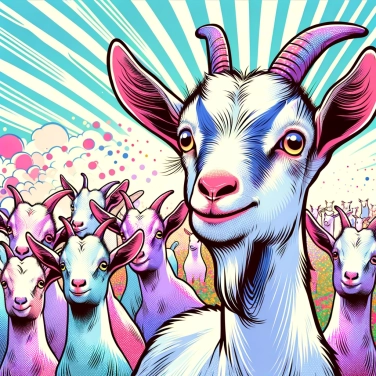The rectangular pupils of goats provide them with better peripheral vision, helping them to spot predators more easily. This shape of pupil also allows them to better assess distances, improving their ability to jump and climb with precision.

Goats are prey animals, so they must quickly detect the arrival of a predator. Their rectangular pupils provide an extended horizontal field of vision, which allows them to better monitor their environment. Very useful when they need to graze peacefully while discreetly keeping an eye on their surroundings. Thanks to this characteristic, they effectively perceive movements across a wide panorama without having to turn their heads too much. These strange pupils are not there by chance: they are simply ultra practical for surviving in the wild.
Rectangular pupils provide goats with an extremely wide panoramic field of vision, ideal for easily spotting predators around them. Thanks to this horizontally flattened shape, they can clearly see forward and to the sides without having to move their head or eyes too much. Horizontal pupils also reduce intense glare from the sun, allowing for better vision even in broad daylight. At night, they capture ambient light on the ground better, where potential dangers often lurk. As a result, goats enjoy optimal visibility, both day and night, without being hindered in their daily activities, especially for grazing while staying alert.
The rectangular shape of the goat's pupil is due to an anatomical feature of the iris, the muscle that controls the amount of light entering the eye. In these animals, the iris has two special muscles arranged laterally, allowing the pupil to stretch horizontally. In full daylight, these pupils can narrow into thin horizontal slits thanks to this specific musculature. Conversely, in low light conditions, they widen to capture more light. The goat's retina also complements this anatomical organization, as it is particularly effective at detecting movements on the horizon. All of this combined creates an anatomy perfectly suited for an animal that effectively monitors its surroundings without having to constantly move its head.
In goats, the rectangular pupils provide a very wide horizontal panoramic view, unlike the round pupils like ours or those of dogs. These horizontal pupils allow for better detection of predators approaching from the sides while remaining focused on the grass they are grazing. In contrast, the vertical pupils of certain predators like cats or snakes help to accurately judge distances for better pouncing on their prey. Each pupil shape generally corresponds to the animal's lifestyle or survival strategy: horizontal for alert prey, vertical for hunting predators, and round for versatile adaptation.
Goats have rectangular pupils, and this clearly affects their daily way of life. Thanks to this, they have an incredible panoramic field of vision, which is super handy for quickly spotting a predator without moving their heads. As a result, they remain calm, but as soon as they detect something strange on the sides due to their enhanced peripheral vision, they quickly run away or get alert. It also influences their grazing behavior: even with their heads down to eat, their eyes constantly scan the horizon, always ready to detect the slightest danger. In short, these pupils make life much easier for them in a nature where staying alert can save your skin.
Goats are not the only animals with rectangular horizontal pupils. Other prey animals like sheep, deer, and some horses also have them for the same evolutionary reasons.
The rectangular shape of goats' pupils enhances their peripheral vision at the expense of their depth perception, which explains why they often hesitate before crossing certain nearby obstacles.
Horizontal rectangular pupils help goats stabilize their vision while grazing, even when they tilt their heads towards the ground, allowing them to continuously monitor their surroundings.
At night, the rectangular pupils of goats can dilate to almost round, maximizing their vision in low-light environments.
Indeed, by observing the pupils of a goat, we can gain some insights into its emotional or physiological state. As with other animals, pupil dilation can reflect fear, excitement, aggression, or changes in the surrounding light intensity.
In addition to goats, several other herbivores such as sheep, cows, and certain species of deer also possess horizontal rectangular pupils. This feature is often associated with an evolutionary adaptation aimed at better detecting predators.
No, the rectangular shape of the pupils has no significant effect on color perception in goats. Color perception is primarily determined by the presence and type of specific cells located in their retina (the cones).
Yes, due to the rectangular shape of their pupils, goats benefit from a wide panoramic field of vision. Unlike humans, they have a broader peripheral vision, but they are less effective at judging depth or clearly distinguishing objects that are right in front of them.
Yes, goats have relatively effective night vision. Their horizontal rectangular pupils allow them to gather more light in low-light conditions, thus enhancing their night vision and their ability to detect predators during twilight or in dim lighting.

No one has answered this quiz yet, be the first!' :-)
Question 1/5